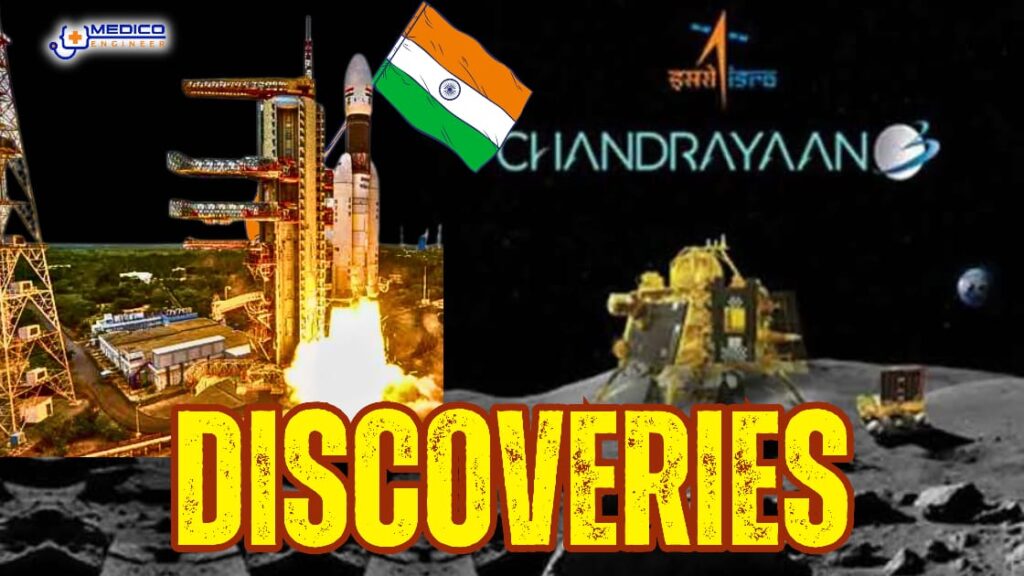Introduction:
Hello, friends! Using Chandrayaan 3, India achieved something unprecedented – a touchdown on the South Pole of the Moon. The world celebrated this success, but did you know that during the Pragyan rover’s mission, it discovered Oxygen and Sulphur on the Moon? In this blog post, we’ll delve into the fascinating discoveries made during Chandrayaan 3’s experiments.

Chandrayaan 3’s Historic Landing:
On 23rd August 2023, Chandrayaan 3 made a successful landing on the Moon’s South Pole. The next day, on 24th August, the Vikram Lander deployed the Pragyaan rover to commence its mission. ISRO kept the world updated through Twitter, providing a glimpse of the rover’s movements.
12 Days of Lunar Exploration:
From 24th August to 4th September, Vikram and Pragyan spent around 12 days making observations on the moon. These observations yielded invaluable insights into the lunar environment. Despite being in sleep mode, there’s hope that they will awaken for more experiments in the future.
CHaSTE Instrument’s Temperature Readings:
On 27th August, the CHaSTE instrument on Vikram Lander took its first readings. CHaSTE, short for Chandra’s Surface Thermophysical Experiment, measured the temperature of the lunar topsoil. Surprisingly, it revealed significant temperature variations just centimeters below the surface, from 60°C on the surface to -10°C at 8 cm depth.
LIBS Confirms Presence of Sulphur:
On 28th August, the Laser Induced Breakdown Spectroscopy (LIBS) instrument confirmed the presence of Sulphur on the Moon’s South Pole. This marked the first-ever in-situ measurement of Sulphur on the lunar surface. LIBS is a sophisticated instrument that analyzes the composition of lunar soil and rocks using high-energy laser pulses.
Oxygen in Moon’s Soil:
Even more astonishing, LIBS and other instruments confirmed the presence of elements like Manganese, Silicon, and Oxygen in the Moon’s soil and rocks. While there’s no atmospheric Oxygen, it exists bonded with other elements in the lunar soil. This discovery opens up possibilities for extracting oxygen for future lunar missions.
Alpha Particle X-ray Spectrometer (APXS):
APXS, another instrument on Pragyan, plays a crucial role in analyzing the general lunar surface. It employs radioactive material to release alpha particles and X-rays, which interact with the lunar surface to identify various elements. APXS’s findings contribute to our understanding of lunar composition.
RAMBHA and Lunar Plasma:
RAMBHA, an instrument on Vikram, measures natural plasma on the Moon. It detected a relatively sparse amount of lunar plasma, indicating favorable conditions for radio wave propagation, essential for communication.
ILSA: Studying Moonquakes:
Instrument for Lunar Seismic Activity (ILSA) records moonquakes, shedding light on the Moon’s interior structure. This knowledge is vital for future lunar settlements and infrastructure.
Vikram Lander’s Hop Experiment:
On 3rd September 2023, ISRO conducted a hop experiment with the Vikram Lander, demonstrating its ability to move on the lunar surface. This is crucial for future human missions, as it ensures safe returns to Earth.
Did Chandryaan find Water on Moon?
Yes, Chandrayaan found water on the Moon. In 2008, the Moon Impact Probe (MIP) on Chandrayaan-1 detected water ice in the lunar soil when it crashed into the surface near the Shackleton crater. This was the first time that water ice had been definitively detected on the Moon.
In addition, the Moon Mineralogy Mapper (M3) instrument on Chandrayaan-1 detected hydrated minerals in sunlit areas of the Moon. This suggested that water was present in the lunar soil in some form, even in areas that were not permanently shadowed.
Since the Chandrayaan-1 discovery, other missions have confirmed the presence of water ice on the Moon, including NASA’s Lunar Reconnaissance Orbiter and Stratospheric Observatory for Infrared Astronomy (SOFIA). Water ice has also been detected in the polar ice caps of Mars and in the moons of Jupiter and Saturn.
Sleep Mode and Hopes for the Future:
On 4th September, both Pragyan and Vikram were put in sleep mode to prepare for the lunar night. ISRO remains hopeful that they will awaken when the lunar day returns, potentially enabling more experiments and discoveries. ISRO said, “Awaiting their awakening around September 22, 2023.” So, hopefully Chandryaan 3 will awake on 22 September 2023, end of lunar night.
Conclusion:
Chandrayaan 3’s mission has unveiled remarkable insights into the Moon’s composition and environment. From the discovery of Oxygen and Sulphur to advancements in lunar plasma research, these findings pave the way for future lunar exploration. As we eagerly await the next lunar day, India’s Lunar Ambassador, Pragyan, stands poised to continue its mission on the Moon’s South Pole.




